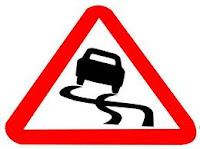Thursday, September 23, 2010
A safer driving experience
Does your car have what it takes to keep you safe and sound?
When many cars can reach extraordinary speeds — some can hurtle along at 250 kilometer per hour — the demand for safety also increases. After seatbelts and airbags, some carmakers have also introduced more advances for safer driving.
German carmaker Mercedes-Benz is no exception.
Some of the safety-related features normally found in a car include airbags (at least four areas equipped with airbags: the driver’s seat and the front passenger seat, rear seats, the sides and the windows), an anti-lock braking system (ABS), brake assistance, night views and an intelligent light system.
The Mercedes-Benz Driving Experience, held recently in Sentul International Circuit, West Java, helped familiarize drivers with safety technology, informed then of the right things they should do in a crisis and, perhaps most importantly, gave hands-on experience in dealing with them.
Different cars were brought to the circuit for a test drive. They include the latest Mercedes-Benz models, such as the C200 CGI, E200 CGI, S500, GL350 CDI, ML 350 and V350.
The CGI stands for charged gasoline injection, meaning that the car applies blue efficiency technology that helps reduce fuel consumption by 9 percent to 22 percent. Despite reduced fuel consumption, the cars can produce 184 horsepower for the C200 and C250 and 204 horsepower for the E200 and E250
The S500 is in a different league compared to the E-class and C-class as it uses a silent V8 engine that can reach 100 kilometers per hour in just 6 seconds. Well, to be precise, in 5.4 seconds, but who’s counting?
The S-class’ air suspension system provides crisp handling and refined comfort. Other features include leather upholstery, electrically adjusted front seats and a roof window.
While the SUV vehicles – GL350 CDI, ML 350 and V350 – are four-wheel drive and built for the rough track, they do not necessarily lack in speed, for these cars also have powerful V8 engines. At the speeds made possible by such engines, drivers should really understand how to maximize the car’s safety technology.
During the Driving Experience event, the first exercise was a slalom, where drivers zig-zagged between cones. The exercise was aimed at enhancing a driver’s visual skills and focus while driving.
Drivers should focus on the space between the cones, but not on the cones. In this exercise, the driver also learns more about how to control the car and the steering wheel. Here, the bulky E-class felt more stable than the slim C-class.
The next exercise was lane changing, which was aimed at controlling the cars in an emergency without using the brakes. Any unstable or sudden movement would activate the car’s electronic stability program (ESP) to prevent the car from skidding.
Curve skid pad exercises emphasized the ABS, anti-skid regulation and electronic traction system. The exercise in the curve skid pad is conducted by placing two wheels on a slippery track, while the other two wheels were on the dry track.
In this exercise, drivers navigate a designated lane separated by cones before building up speed and hitting the brake pedal at an assigned spot just a few meters before the car reaches the skid pad.
A speed monitor was placed at the assigned spot. Drivers should run their cars at a speed between 80-85 km per hour and the car should stop before the last cone. When the instruction was followed carefully, the braking system met the required speed.
For example, if the car was accidentally driven into the gravel areas, drivers received notice in the shape of an exclamation mark on the panel menu. During the exercise, seatbelts will automatically tighten as they sense the passengers’ swaying bodies when the cars are drifting. While it surely is safe, women may find it a bit uncomfortable.
For the SUVs, the test drive was more challenging, with built-up ram track to try out the downhill speed regulation feature, braking system, 4 ESP and four electronic traction system that keeps the wheels rolling even if one of the wheels is not touching any ground and pyramid track to try the dynamic driving suspension.
After completing the whole series of exercises, it was obvious that the cars are not only made for speed, but also for safety when a situation arises
Subscribe to:
Post Comments (Atom)

No comments:
Post a Comment